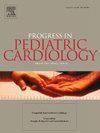Risk of neurodevelopmental delay in children with congenital heart defects: Hospital based prospective cross-sectional study
IF 0.8
Q4 PEDIATRICS
引用次数: 0
Abstract
Background
The effect of congenital heart defects (CHDs) on adverse neurodevelopment has been reduced with modern medical services in high-income countries. This is in contrast to low-and-middle-income countries where the benefits of modern medical advantages are practically non-existent.
Objective
Determine the risk of developmental delay in children with CHD and examine associated factors.
Method
A hospital-based prospective cross-sectional study was conducted on 288 children from 2 to 60 months of age with CHDs. Data were collected prospectively from August 15, 2024 – January 15, 2025. Development assessment was conducted using the “CDC's Milestone Moments booklet.” Logistic regression was performed to see the association of independent variables with the dependent variable – development delay. A P-value of ≤0.05 was considered significant. SPSS version 27 was used for analysis.
Result
Of the studied children with CHDs, 51 % were females. The mean (SD) age was 18 months (16). Delayed development was seen in 46 % of the studied children. The motor domain is the most affected development domain (42 %). Rural residency {AOR = 2.21, 95 % CI = (1.08, 4.53)}, suspected genetic/syndromic comorbidity {AOR = 18.92, 95 % CI = (7.91, 45.24)}, severe stunting {AOR = 5.91, 95 % CI = (2.67, 13.11)} and dextro-transposition of great arteries (d-TGA) {AOR = 58.56, 95 % CI = (4.97, 689.6)} were statistically significant associated factors.
Conclusion
The risk of neurodevelopmental delay is a common problem in children with CHD. Suspected genetic/syndromic comorbidities, severe stunting, rural residency, and d-TGA are statistically significantly associated factors with neurodevelopmental delay in a developing nation.
先天性心脏缺陷儿童神经发育迟缓的风险:基于医院的前瞻性横断面研究
高收入国家的现代医疗服务已经降低了先天性心脏缺陷(CHDs)对神经发育不良的影响。这与低收入和中等收入国家形成鲜明对比,在这些国家,现代医疗优势的好处实际上是不存在的。目的探讨冠心病患儿发育迟缓的风险及相关因素。方法对288例2 ~ 60月龄冠心病患儿进行前瞻性横断面研究。数据收集时间为2024年8月15日至2025年1月15日。开发评估是使用“CDC的里程碑时刻小册子”进行的。采用Logistic回归分析自变量与因变量发育滞后之间的关系。p值≤0.05被认为是显著的。采用SPSS第27版进行分析。结果在所研究的冠心病患儿中,51%为女性。平均(SD)年龄为18个月(16)。46%的被研究儿童发育迟缓。运动领域是最受影响的发展领域(42%)。农村居住{AOR = 2.21, 95% CI =(1.08, 4.53)}、疑似遗传/综合征合并症{AOR = 18.92, 95% CI =(7.91, 45.24)}、严重发育迟缓{AOR = 5.91, 95% CI =(2.67, 13.11)}和大动脉右转(d-TGA) {AOR = 58.56, 95% CI =(4.97, 689.6)}是具有统计学意义的相关因素。结论神经发育迟缓是冠心病患儿的常见问题。在发展中国家,疑似遗传/综合征合并症、严重发育迟缓、农村居住和d-TGA是与神经发育迟缓有统计学意义的相关因素。
本文章由计算机程序翻译,如有差异,请以英文原文为准。
求助全文
约1分钟内获得全文
求助全文
来源期刊

PROGRESS IN PEDIATRIC CARDIOLOGY
PEDIATRICS-
CiteScore
0.90
自引率
11.10%
发文量
69
审稿时长
75 days
期刊介绍:
Progress in Pediatric Cardiology is an international journal of review presenting information and experienced opinion of importance in the understanding and management of cardiovascular diseases in children. Each issue is prepared by one or more Guest Editors and reviews a single subject, allowing for comprehensive presentations of complex, multifaceted or rapidly changing topics of clinical and investigative interest.
 求助内容:
求助内容: 应助结果提醒方式:
应助结果提醒方式:


